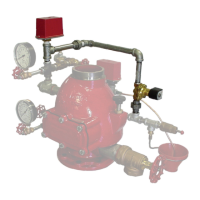TFP110 0
Page 2 of 16
NOTICE
Quick operation of the Electronic
Ac celerator does not ensure that the
fire protection system will meet the
water delivery time requirement of the
authority having jurisdiction (following
opening of the Inspector’s Test Con-
nection). The sprinkler system designer
must be knowledgeable that water
delivery time is primarily determined
by the configuration and volume of the
piping network, system air pressure at
time of Accelerator trip, number and
orifice size of open sprinklers, and
water supply characteristics.
In the case of a double interlock pre-
action system, water delivery is also
based on the electric detection system
operating before the first sprinkler
activates.
Dry Pipe Valve Compatibility
The Model QRS Electronic Accelerator
is UL Listed and FM Approved for use
with the following dry pipe valves:
•
4 in. and 6 in. (DN 100/150) TYCO
DPV-1 3 in. (DN80) Central AF
•
4 in. and 6 in. (DN100/150) Central
AF/AG
•
4 in. and 6 in. (DN100/150) Gem
F302/F3021
•
4 in. and 6 in. (DN100/150) Star
Model A
•
4 in. and 6 in. (DN100/150) Star
Model A-1
Preaction System Compatibility
The Model QRS Electronic Accelerator
is UL Listed and FM Approved for use
with the 1-1/2 in. through 8 in. (DN40
through DN200) DV-5A Double Inter-
lock Electric/Electric Preaction System.
Refer to Technical Data Sheet TFP1450.
Maximum Working Air Pressure
70 psi (4,8 bar)
Pressure Decay For Trip Rating
0.1 psi/sec. (0,007 bar/s)
High/Low Pressure Settings
See Table A.
Environmental Specifications
The QRS Quick Release Switch is for
indoor use only (NEMA 1/IP50).
Battery Back-Up
Battery back-up for dry pipe systems
is provided by two BT-120 (12 AH) bat-
teries or two (optional) BT-180 (18 AH)
batteries. See the Ordering Procedure
section for details.
The two BT-120 batteries provide:
•
40 hours in standby with four QRSs
•
With four QRSs connected, with
one in alarm and the solenoid
activated continuously, the batteries
will provide 12 additional hours of
standby
•
With three QRSs connected, with
one in alarm and the solenoid
activated continuously, the batteries
will provide 13 additional hours of
standby
•
With two QRSs connected, with
one in alarm and the solenoid
activated continuously, the batteries
will provide 14 additional hours of
standby.
For double interlock preaction systems,
battery calculations must be performed
by the system designer to determine
adequacy of the two batteries to meet
the requirements of the authority having
jurisdiction.
A battery calculation form can be
accessed on the Potter website at
http://www.pottersignal.com/fire/
batterytools/php
Installation
The TYCO Model QRS Electronic
Accelerator must be installed in accor-
dance with this section.
Step 1. The QRS Electronic Accelera tor
Riser Components (P/N 52-312-2001)
must be installed per Figure 2 or 8 as
applicable. The DV-5A Double Interlock
Preaction Trim with Electric/Electric
Actuation and Model QRS Electronic
Accelerator must be installed per
Figure 3A or 3B. The solenoid valve
must be installed with its flow direc-
tion arrow as indicated. Apply the
pipe thread sealant sparingly to male
threads only.
Step 2. The Releasing Panel is to be
located in a dry and protected area;
however, it should be located in close
proximity to the valve riser(s). In the
case of one panel being used for mul-
tiple dry pipe valve risers, it is recom-
mended that a single panel only be
used when the multiple risers are adja-
cent to each other. Otherwise, difficulty
may be encountered when performing
the resetting procedure.
Step 3. The QRS Quick Release
Switch, Solenoid Valve, and Releas-
ing Panel must be wired per Figure 5
or 6, as applicable. All electrical con-
nections are to meet the requirements
of NFPA 72.
NOTICE
Figure 5 provides the wiring connec-
tions for dry pipe systems using the
PFC-4410RC Standard Program #14.
Figure 6 provides the wiring connec-
tions for a double interlock elec tric/
electric preaction system using the
PFC-4410RC Standard Program #13.
In the case of Figure 5, the EOLR for
the supervisory circuit is located in
the last QRS Quick Release Switch. In
the case of Figure 6, the EOLR for the
supervisory zone is located at the QRS
and the orange and yellow wires are not
used. Any tamper switches for sys tem
shut off valves required for double
interlock preaction systems should
be connected to Zone 3 of the PFC-
4410RC releasing panel which is pro-
grammed as a Tamper Zone. Refer to
PFC-4410RC Manual #5403550.
All QRS wiring must be terminated
(landed) while the PFC-4410RC is de-
energized. Failure to do so may result in
unseen damage to the QRS, rendering
it inoperable.
To de-energize the PFC-4410RC, dis-
connect the stand-by batteries, then
disconnect the A/C input. Reverse this
process to re-energize the panel.
For additional PFC-4410RC Releasing
Panel information (for example, power
and battery connections, program-
ming, and basic operation) refer to the
Potter Electric Signal Company Manual
#5403550.
Step 4. As a function of the nominal air
pressure to be maintained in the sprin-
kler system, set the 10 position, high/
low level, rotary switch setting of the
QRS Quick Release Switch using the
information provided in Table A as well
as inside the cover of the QRS Quick
Release Switch.
Step 5. To complete the installation, the
cover of the QRS Quick Release Switch
must be securely fastened to the base
to ensure metal-to-metal contact, and
the PFC-4410RC Releasing Panel
must be programmed using Standard
Program #13 or #14, as ap plicable. Pro-
gramming instructions are provided in
Potter Electric Signal Company Manual
#5403550.

